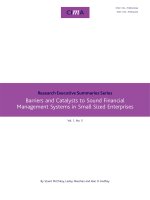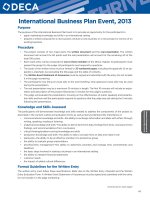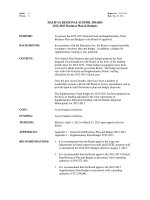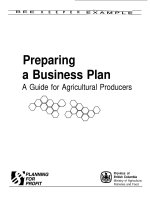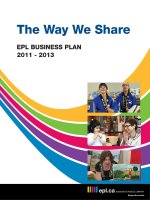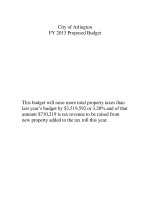Business plan to invest honeycomb paper line in he vi trading producing company limited
Bạn đang xem bản rút gọn của tài liệu. Xem và tải ngay bản đầy đủ của tài liệu tại đây (1.8 MB, 91 trang )
TR
NG
IH CM
TP.HCM
HO CHI MINH CITY OPEN UNIVERSITY
UNIVERSITÉ LIBRE DE BRUXELLES
SOLVAY BRUSSEL SCHOOL
MBAVB3
BAO TRAN DO HOAI
BUSINESS PLAN
TO INVEST HONEYCOMB PAPER LINE IN HE VI
TRADING PRODUCING COMPANY LIMITED
MASTER PROJECT
MASTER IN BUSINESS ADMINISTRATION
(PART – TIME)
Tutor’s Name: Dr. Prof. TRINH THUY ANH
Ho Chi Minh City
(2010)
i
Certificate
By this writing, I want to confirm that this project has not already been submitted
for any degree or duplication from others.
I certify that I have myself studied and researched the project’s problem with my
best knowledge thru applied the academic knowledge obtained from the MBA
program.
Ho Chi Minh City, 20 February 2011.
Signed: TRAN DO HOAI BAO
ii
ACKNOWLEDGEMENT
To carry out the success of final project, I owe a debt of gratitude to many people
who helped me complete this thesis. I would like to acknowledge the help of all.
First of all I would like to express my deepest acknowledgement to my tutor,
Professor Trinh Thuy Anh from the Ho Chi Minh City Open University, for her
guidance, valuable advice and. I could not find out any word to express my
heartfelt to thank her.
My grateful acknowledgement is extending to the Université Libre de Bruxelles –
Solvay Business School and Open University of HCMC, which provided me a a
specialist knowledge in this part time MBA program.
I would like to thank all my classmate, friends and colleague who support me
during the study related to data collection.
Finally, I am indebted to my parents and my wife, I would like to express my
profound gratitude to my beloved parents thanks for their encouragement. My
greatest debt of gratitude is to my wife, Mrs. Nguyen Thi Tuyet Trinh, who is
always beside me during my study. This thesis could not have been written
without her daily encouragement.
iii
COMMENTS OF TUTOR
…………………………………………………………………………………………………………………………………………………………………
…………………………………………………………………………………………………………………………………………………………………
…………………………………………………………………………………………………………………………………………………………………
…………………………………………………………………………………………………………………………………………………………………
…………………………………………………………………………………………………………………………………………………………………
…………………………………………………………………………………………………………………………………………………………………
…………………………………………………………………………………………………………………………………………………………………
…………………………………………………………………………………………………………………………………………………………………
…………………………………………………………………………………………………………………………………………………………………
…………………………………………………………………………………………………………………………………………………………………
…………………………………………………………………………………………………………………………………………………………………
………………………………………………………..
Ho Chi Minh City, …….. February, 2011
Tutor
Dr. TRINH THUY ANH
iv
TABLE OF CONTENTS
Certificate ................................................................................................................... i
Acknowledgements.................................................................................................... ii
Comments of tutor ................................................................................................... iii
Table of contents ...................................................................................................... iv
Glossary of terms and abbreviations .................................................................... viii
List of figures & chart .............................................................................................. ix
List of tables ............................................................................................................... x
Executive summary .................................................................................................. xi
Chapter 1
INTRODUCTION OF THE PROJECT
1.1 Rational of the project ........................................................................................ 1
1.2 Research question................................................................................................ 2
1.3 Objectives of the project ..................................................................................... 2
1.4 Research methodology and data collection ........................................................ 3
1.4.1 Methodology ....................................................................................... 3
1.4.2 Data required for this business plan ................................................... 3
1.4.3 Scope and limitation of the research study ......................................... 4
1.5 Project Process .................................................................................................... 5
Chapter 2
HONEYCOMB PAPER OVERVIEW & BUSINESS PLAN
2.1 Brief information on honeycomb paper .............................................................. 6
2.2 Honeycomb paper application ............................................................................ 8
2.3 Opportunity assessment .................................................................................... 10
2.4 Market research ................................................................................................. 12
2.5 Business plan .................................................................................................... 13
v
2.6 Financial appraisal ............................................................................................ 13
2.6.1 Payback period (PBP).......................................................................... 13
2.6.2 Net Present Value (NPV) .................................................................... 14
2.6.3 Internal Rate of Return (IRR) ............................................................. 14
2.6.4 Break-even point (BEP) ...................................................................... 15
Chapter 3
MARKET ANALYSIS
3.1 HE VI TPC overview
3.1.1 HE VI TPC profile ............................................................................... 17
3.1.2 Management team and structure ......................................................... 18
3.2 Paper packaging market overview .................................................................... 18
3.3 Market analysis
3.3.1 Local market ........................................................................................ 20
3.3.2 Oversea market.................................................................................... 21
A. Wood & Furniture export ...................................................................... 23
B. Electric & electronic ............................................................................. 24
C. Food & beverage................................................................................... 25
D. Handicraft ............................................................................................. 26
3.3.3 Opportunities
A. Macro economic ................................................................................... 26
B. Legislation............................................................................................. 27
C. Opportunities ......................................................................................... 28
3.3.4 Analysis of Five Forces Forter
A. New entrants ......................................................................................... 30
B. Substitutes ............................................................................................. 30
C. Power of buyers .................................................................................... 31
D. Power of suppliers................................................................................. 31
E. Industry competitors .............................................................................. 31
vi
Chapter 4
BUSINESS PLAN
4.1 Market and sales
4.1.1 Input factors ........................................................................................ 32
A. Place ................................................................................................... 32
B. Construction and facilities cost ........................................................... 33
C. Cost of honeycomb paper line and transportation ............................... 35
D. Payroll and other expenses .................................................................. 36
E. Annual Cost & Expenses Estimation ................................................... 37
F. Honeycomb capacity and Sales ............................................................ 40
4.2 Financial Analysis ............................................................................................ 41
4.3 Action plan ........................................................................................................ 46
4.3.1 Capital ................................................................................................ 46
4.3.2 Human resources ............................................................................... 46
4.3.3 Materials ............................................................................................ 47
4.3.4 Marketing Plan ................................................................................... 47
Chapter 5
CONCLUSIONS AND RECOMMENDATIONS
5.1 Conclusions ....................................................................................................... 49
5.2 Recommendations.............................................................................................. 50
vii
Glossary of terms and abbreviations
BEP
Break-even point
EU
European Union
FDI
Foreign Direct Investment
F&B
Food & Beverage
GDP
Gross Domestic Product
IRR
Internal Rate of Return
NPV
Net Present Value
PBP
Payback period
PC
Present Cost
PV
Present Value
ROsH
Restriction of Hazardous Substances Directive
USA
The united state of America
USD
United States Dollar
VND
Vi t Nam đ ng
WTO
World Trade Organization
viii
LIST OF FIGURES & CHART
Figure 1.1: Project Process ................................................................................... 5
Figure 2.1: Honeycomb paper panel process ....................................................... 8
Figure 2.2: Honeycomb paper .............................................................................. 9
Figure 2.3: Honeycomb paper door ...................................................................... 9
Figure 2.4: Honeycomb paper board and its shape ............................................ 10
Figure 2.5: Honeycomb paper pallet .................................................................. 10
Figure 2.6: Product life cycle ............................................................................. 11
Figure 2.7: The normal distribution of adopter .................................................. 11
Figure 2.8: Business plan structure .................................................................... 13
Figure 3.1: Organization structure ...................................................................... 18
Figure 3.2: Sale process ..................................................................................... 18
Chart 3.1: Paper packaging consumption (Unit: 1,000 tons) .............................. 19
Chart 3.2: Paper consumption in some countries in Asia ................................... 19
Chart 3.3: Paper consumption in Asia (Unit: million tons)................................. 19
Chart 3.4: Capital and output growth rate .......................................................... 20
Chart 3.5: The density of plastic industry chart.................................................. 20
Chart 3.6: Construction output value .................................................................. 20
Figure 3.3: Department in Vietnam ................................................................... 21
Chart 3.7: Export turnover rate per Vietnam’s GDP .......................................... 21
Chart 3.8: Vietnam export turnover from 2006 to 2009 .................................... 22
Chart 3.9: Export turnovers was divided into economic structure ..................... 23
Chart 3.10: 8 goods exported over 2 billion USD in 2008 ................................. 23
Chart 3.11: Density of Wood & Furniture Export in Y2009 .............................. 24
ix
Chart 3.12: Wood & furniture export turnover at some countries in year 2008 &
2009 .................................................................................................................... 24
Chart 3.13: Wood & Furniture export turnover from 2006 – 2009 .................... 24
Chart 3.14: Electronic and electric component export turnover from 2006 -2009
............................................................................................................................ 25
Chart 3.15: Fruit export turnover of Vietnam nine months 2009 ....................... 26
Chart 3.16: Handicraft export turnover from 2006 – 2009................................. 26
Chart 3.17: Vietnam GDP by sector ................................................................... 27
Chart 5.1: Distribution Turnover ....................................................................... 52
x
LIST OF TABLE
Table 3.1: Vietnam Plastic ............................................................................................. 20
Table 3.2: International comparison about economy growth rate .................................. 27
Table 3.3: Limitation of some chemical for producing packaging ................................. 28
Table 3.4: Total cost comparison for common packaging .............................................. 29
Table 4.1: Area separation of the premises ................................................................... 33
Table 4.2: Cost of construction ...................................................................................... 34
Table 4.3: The facilities cost of factory .......................................................................... 34
Table 4.4: The facilities cost of office and guard room ................................................. 35
Table 4.5: Honeycomb paper line and truck cost ........................................................... 36
Table 4.6: Payroll for staff ............................................................................................. 36
Table 4.7: Total Investment and Apportionment Estimation ......................................... 37
Table 4.8: Production costs through 10 years ................................................................. 38
Table 4.9: Management & sales cost, Payable annually................................................ 39
Table 4.10: Fixed and variable costs ............................................................................. 39
Table 4.11: Price comparison with main competitor ...................................................... 41
Table 4.12: Thickness, Quantity and Price estimation ................................................... 41
Table 4.13: Annual Profit and Loss ................................................................................ 42
Table 4.14: PBP with discount rate, NPV, IRR .............................................................. 43
Table 4.15: Breakeven point in the project .................................................................... 44
Table 4.16: Estimate Market share and size for honeycomb paper packaging .............. 45
Table 4.17: Evaluation for the sensitivity of project ............................................ 46
Table 4.18: Investment capital prepaid .......................................................................... 47
xi
EXECUTIVE SUMMARY
Nowadays, when human life is more and more developed, their needs are also
increased. One of them is to be live in the healthy environment that is often affected by
industrialization. To minimize this status, Johannes Meier with the topic is ““Process
for the production of a honeycomb core from foil strip utilizing a position
detector”, his patent number is 5277732 helps us improve this problem somewhat.
“Using honeycomb paper for packaging” is the way he created to safeguard
environment. In terms of environmental efficiency, it helps to reduce the heavy air
pollution. In terms of economic efficiency, it makes the products were lighter 70% than
those made of chipboard and so on.
Until now, many countries and organizations have appealed everyone for using recycle
material to protect our environment instead of the scarce wood resources and plastic is
hard to disintegrate. Therefore, honeycomb paper is the best choice as a solution
reducing to cut woods and use plastic in the world. The other hand, the developed
countries such as America, European set up law as EU Directive 2002/95/EC, EU
Directive 2002/96/EC to protect themselves from others. The objective of these
legislations is to increase the recycling and/or re-use of such products. Or EU Directive
2004/12/EC and America on packaging and packaging waste aims to harmonize
national measures concerning the management of packaging and packaging waste in
order, on the one hand, to prevent any impact thereof on the environment of all
Member States as well as of third countries or to reduce such impact, thus providing a
high level of environmental protection.
In addition, Vietnam is one of countries has grown rapidly and top of attracting FDI in
the world. So the new demand is shaping a new market of honeycomb paper in
packaging market. This project is to build a business plan for honeycomb paper line in
Vietnam and in the South of Vietnam in particular. In terms of structure, this thesis has
five chapters. Chapter one is to define the research problems and questions, and
xii
providing a justification for the research study. Chapter two also reviews honeycomb
paper and business plan. Chapter three examines the economic background, and
analyzes the market. Chapter four is to focus on business plan analysis to understand
costs and expenses for initial investment, to appraise its feasibility of the project
through the financial indexes as NPV, IRR, PBP and so on. The result of financial
evaluation will help He Vi has an action plan appropriate for them. And the final is
conclusions and recommendations.
Page 1 of 52
Chapter 1
INTRODUCTION OF THE PROJECT
1.1 Rational of the project
Nowadays, development of the world economy has led to the development of many
different industries. With the strong and rapid growth of economy and
industrialization process has influenced our earth. Our planet is in trouble! Almost
every day we seem to hear of yet another problem affecting the environment and
what a list of problems! - pollutions, acid rain, climate change, the destruction of
reinforest and other wild habitats, the decline and extinction of thousands of species
of the animal and plants and so on.
Most of us know that these threatening exits have been caused. Many people are
very worried about the future of our planet. So, some development countries (US,
European Union, e.t.c) have found a way of solving those problems to protect our
environment by green barriers. They demand that one of goods imported in their
countries should be used recycle paper for packaging, avoid using styro-foam,
plastic products. Using recycle paper is one of the ways that help us make the green
barriers.
The economic recession in 2007 and 2008 influenced more or less the activities of
all Companies in trading, producing and servicing in general and HE VI TPC in
particular. In the end of the year 2009, Vietnam’s economy is gradually well,
(especially, the export of Vietnam, total export turnover is around 56.5 billion US
dollars in 2009. And the expectation export will rapidly increase in 2010, this is a
potential market for the packaging industry development), most of companies have
been prepared to plan themsefves for getting back their market including He Vi
TPC. Because of the establishing company, it has not have any plan to invest
MBA VB3 | TRAN DO HOAI BAO
Page 2 of 52
machines for long term development yet. To define what it should do invest in order
to serve the market better in future, it is demanded to have a business plan.
HE VI TPC works in the packaging fields, its products are paper pallet, honeycomb
paper which produced by semi-automatic. There are few companies produce same
our products in the Vietnamese market using honeycomb paper machinery. From
the signals, the observation of the export and the development of wooden market,
as a foreseeable, our company has planed to invest honeycomb paper line as a
substitute for wooden, iron, plastic pallet, and foam in the packaging field with
some advantages as free fumigation, recyclable with environmental protection
performance and to make high effective in environment protective process
according to ROsH standard of European Union and USA, or IKEA ways. This
project is developed with those reasons above from the market demand, business
objectives, finance appraisal and finally decide to invest or not invest this line for
HE VI TPC. Hence, the project is very necessarily to carry out.
1.2 Research question
Research questions are to answer for “problem” which needs to be solved. The
research problem leads to the research question as following:
•
What is size of the honeycomb paper market?
•
How many percents of market share can He Vi TPC get from this
investment?
•
How long will this project get payback?
•
What is the profitability this project brings in?
1.3 Objectives of the project
The above information is considered as a problem about the environment protection
by using more proper products to protect our planet. To find some solutions for
reducing use plastic & wood products and increasing use honeycomb paper products
MBA VB3 | TRAN DO HOAI BAO
Page 3 of 52
so the project has to be implemented to find out what this project brings in and
assess the market to look for opportunity. In answering the research questions
mentioned previously, objectives of the project are:
(1) To collect informations in the export and domestic contruction market. (2) To
deep understand the market tendency and customer’s expectation. (3) To appraise
the honeycomb paper investment and build the action plan in Vietnam market. (4)
To find the opportunities from the market and to bring the competitive advantage
for HE VI TPC.
These objectives explain the purpose of the project and problem–solving research.
1.4 Research methodology and data collection
1.4.1 Methodology
Based on the books as Claire Gruslin (2008, slide 29, ULB) and Tran Xuan Kiem,
Nguyen Van Thi (2004, pape 20, Marketing Research), there are three types of
research design: exploratory, descriptive, and causal.
To chooose research design, we have to depend on research questions which the
researcher wants to be answered. This research is designed to looking for
honeycomb paper market and its application in Vietnam. Therefore, exploratory
research was chosen as a fit research in this study. This one belongs to qualitative
research.
1.4.2 Data required for this business plan
After selecting research design, the next step is to choose types of study. There are
three types of research from which selected by researcher: interview with experts,
desk research, and qualitative, Claire Gruslin (2008, slide 29, ULB), Because this is
a new research in the market and few people understand about honeycomb paper
product so we will apply qualitative research to explore/collect more ideas insight of
this problem. The research will be implemented by depth interviews to the
MBA VB3 | TRAN DO HOAI BAO
Page 4 of 52
selective interviewees. This method will help to collect and classify data to become
a report and recognize the problem. The research is mainly made via in-depth
interviews, which were directly made by the researcher (writer) towards the
customers (B2B) who are mainly the owners, directors and vice directors of their
company and deep interview is made with each respondent separately at their
factory or home depend on interviewees. Each interview time is around 1 to 2 hours.
The secondary data method, the researcher needs to collect the primary data
which is collected via desk research, was used to analyze the market situation in
Viet Nam. Some informations such as growth of timber and handicrafts, foreign
direct investment (FDI) will conduct for developing of paper packing industries.
After collecting data and start to analyze and appraise them to find market needs.
The secondary data is sourced from Statistical Office in HCMC on the import &
export, and focus on export market. Another data source of collection is derived the
actual reports from Vietnam Forest Corporation (Vinafor), Handicraft and wood
industries association of HCMC (HAWA), Vietnam association of handicraft
exporter (Vietcraft), and other ones is from some website on internet.
1.4.3 Scope and limitation of the research study
Limitations of time, funding and scope of the study required the research study to
focus on a limited number of objectives. So, the research is conducted to learn about
the customers who are willing to try and apply honeycomb paper for substitute wood
and plastic in packaging.
Because of limited access to scarce resources, this study could not research in all
exporter and domestic of Vietnam but only selected interviewees located in Ho Chi
Minh City and Binh Duong Province as the target population and this study is
applied for the business of honeycomb paper, not for other kinds of paper. Most of
figures are collected from year 2006 to year 2009 for analyzing in this study. And
this project focus on analyzing financial plan to make clear that project is feasiable
or not to support for Board of Management with the correct investment.
MBA VB3 | TRAN DO HOAI BAO
Page 5 of 52
1.5 Project Process
This research is structured into 5 chapters. Chapter 1 introduces overview of
research including research background, research problem, research questions,
research objectives, scope and limitation of the research study. Chapter 2 provides
brief information of honeycomb paper, development of honeycomb paper in the
world and a literature review of market research, business plan and especially
financial appraisal for this project. Chapter 3 discusses market of honeycomb paper
in Vietnam, research process and research analysis. Chapter 4 analyses business
plan. Chapter 5 points out conclusions and recommendation for theses. Figure 1.1
shows the project process and the relationship between chapters.
MBA VB3 | TRAN DO HOAI BAO
Page 6 of 52
Chapter 2
HONEYCOMB PAPER OVERVIEW & BUSINESS PLAN
This chapter is to provide some informations about honeycomb paper helps us to
understand what honeycomb paper is and some previous researches as well as review
theories which support of business plan. It gives a foundation to research and assess the
market, to set a business plan and to lead us in the right way.
2.1 Brief information on honeycomb paper
Honeycomb paper is a structure of hexagonal cells constructed similar to honeycomb. It
has advantage of light weight, high rigidity, resistance to shearing force and pressure.
And it also has good performance on thermal isolation, acoustic isolation, shock and
vibration absorption.
History of honeycomb paper
After the secondworld war, honeycomb paper was introduced for the airplane industry
as a cost and material saving product for the reconstruction of Europe. Because at that
time there was a shortage of building material (wood, bricks, etc.) honeycomb paper
was an excellent alternative for solid materials like wood. In the sixties honeycomb
paper was mainly used in inner doors, partition and furniture such as kitchen cabinets.
However chipboard was becoming cheaper and cheaper in the 1970s, honeycomb paper
was pushed out of many applications. Since then it was mainly used in inner door or as
a packaging material for protecting all kind of items which anti-shock, drop test and so
on. In the eighties, honeycomb paper was used again by producing as a constructive
filling, the products were lighter 70% than those made of chipboard, for example. This
was convenient for clients purchasing cabinets or bookshelves assembled at home. In
the nineties and 2000s paper honeycomb was introduced in the automotive industry. It
MBA VB3 | TRAN DO HOAI BAO
Page 7 of 52
is often used as a substitute for a wooden plate with a steel frame for the trunk plate.
Most of them was used in furniture was greatly increased and diffused in US and EU.
Until now, it is necessary to protect our environment in the future. The government
from many countries force people has to use honeycomb paper as a solution to make
green environment to reduce cutting wood and using plastic in the world. Therefore,
honeycomb paper will be used more and more.
History of technology
At technology’s part, we will understand about how to produce honeycomb paper from
paper roll and some of last honeycomb paper researches with its development in the
world.
In the sixties of last century, they have invented 2 basic methods for producing
honeycomb paper as follow:
1
The first is using from 2 paper rolls the paper is guided on a glue roller which brings
glue lines in the length direction on the paper. The distance between the gluing lines
defines the cell sizes of the honeycomb. The 2 paper layers are winded on a big
winding drum. The drum shall continuous wind whenever layers is nearly full and then
the paper layers are cut in big block, after this process the big block will be cut into
small blocks of the exact thickness of the desired honeycomb thickness.
The second is call “cascading technology” from 2-4-6-8 or 12 paper rolls the paper is
guided on a glue roller which brings glue lines in the length direction on the paper.
They will be stacked to become a block after that this block is guided through a cutting
knife which cut the paper layers directly on the correct thickness of the desired
honeycomb.
Both researches above are to make honeycomb paper became a product which saving
cost and light material for using in inner doors, separate wall and furniture such as
kitchen cabinets and so on, but honeycomb paper was pushed out many applications by
chipboard because of the cheaper price since the 1970s.
1
www.paper honeycomb.com
MBA VB3 | TRAN DO HOAI BAO
Page 8 of 52
However, via the development of the market, Johannes Meier, Neuhausen,
Switzerland, have innovated honeycomb paper core with two face was laminated by
paper or composite plate to make honeycomb paper turn back market in 1994. Johannes
Meier invented a machine to produce honeycomb paper panel to serve for packaging or
light panel with topic is “process for the production of a honeycomb core from foil
strip utilizing a position detector” and his patent number is 5277732 (code:
US005277732A)2. The patent is tell us about how to produce honeycomb paper panel,
Figure 8 from patent illustrate the application of the stack produced by process of the
invention, preferably using the equipment of the invention for the production of
composite plate with an expanded honeycomb core and covering layers. The
honeycomb paper sandwich(40,fig2.1) passes through an expander device consisting
essentially of two rollers arranged on either side of the stack, the surfaces of these
rollers being covered with brushes
(49,50,fig2.1)
. The brushes will keep honeycomb for
expanding process after passing through the rollers
(84,85,fig2.1)
the honeycomb paper
sandwich has been stretched to an expanded honeycomb core. This expanded
honeycomb core is covered on front edges of the honeycomb cells on both sides with an
adhesive, preferably in the form of adhesive foil
(84,85,fig2.1)
and the covering layers are
laid on the top of this as figure 2.1 shows in appendix 1.
This radical invention gradually honeycomb get back the market and become a product
support for packaging effectively and substitute for wood and plastic nowadays.
2.2 Honeycomb paper application
As we know, many countries have asked their citizen reduce to use plastic and wood in
their life in the world, Vietnam in there. Vietnam has appeal to citizen for reducing
plastic in packaging through “green environment campaign” by using paper bag or
disintegration bag and so on. So we can recognize that the important of recycle paper in
2
US patent US005277732A
MBA VB3 | TRAN DO HOAI BAO
Page 9 of 52
our life to protect our planet as USA, EU and e.t.c have done. To reduce using plastic
and wood, they have found which products are fit for those problems are honeycomb
paper and its panel to support for packaging without wood and plastic.
Honeycomb paper and its panel
Honeycomb paper
Honeycomb paper support for furniture and handicraft Companies because of
hexagonal structure. It helps to save cost and time in the producing process (Figure 2.2).
As a applicable to the inner packaging of top grade products such as arts and crafts,
ceramics etc., it is protective against fragile articles. Various honeycomb plate products
can be made through the recombination of honeycomb paper core and paperboard such
as: fiber board, veneer board, decoration board, steel board, aluminum board, for
example, to be applied to furniture, doors, table, light & sound partition walls, floor
screens, internal decorative sheets of vehicles and ships.
Paper honeycomb are used in the furniture industries. Because the panels have a very
low weight it is easy for the take away furniture, but also for high quality furniture it is
and can be used by using a small honeycomb cell size (15 mm) and for example 3 mm
MDF/chipboard you will have a very stable sandwich construction (figure 2.3).
Honeycomb paper panel
Honeycomb cardboard is manufactured according to honeycomb structure principle and
conglutinated by glue-water into numerous hollow stereo regular hexagons. It is formed
through conglutination of tissues in the two sides and made up a sandwich plate with
many different size of panel. This one is to make honeycomb paper panel is
increasingly popular and used in packaging to replace for foam, wood and so on. With
the flexibility of honeycomb panel, it helps producer easy to produce many shape to
serve packaging market nowadays.
The main characteristics of honeycomb cardboard are as follows:
Light, low consumption for material, light in weight
MBA VB3 | TRAN DO HOAI BAO
Page 10 of 52
•
Not easy to deform. Its outstanding pressure resistance and bending resistance
are the most important properties that case packaging materials require.
•
Good shock resistance and cushioning performance. Honeycomb cardboard is
made of flexible paper cores and tissues with favorable toughness and rebound
elasticity. The unique honeycomb sandwich structure provides excellent
cushioning performance. It is endowed with high unit volume energy absorption
value. Honeycomb cardboard with high thickness can be used as a substitution
for EPS plastic foam cushion used popularly now.
•
Sound absorption& heat insulation. Inside the honeycomb sandwich structure is
a closed space full of air, thus it is endowed with favorable sound insulation and
heat preservation performance.
•
Pollution free in accordance with modern environmental protection requirement.
All honeycomb cardboard are made of recyclable papers, 100% recycled after
use.
•
Honeycomb cardboard is an environmental paper packaging material with high
strength, light weight and wide application popular in recent years. Thicknesses
from 1 cm to no limit are available. It can be applied to various packing boxes,
pads, furniture, floors, car inner decorations, and so on. Heat & sound insulation,
light, low in price, it can be used as a substitute for wood, plastic etc. in many
occasions. (Figure 2.4 & 2.5)
2.3 Opportunity assessment
Through the course of Prof. François Faelli, the evaluation of a business opportunity is
based on some main factors. The first point is the market size as market size, market
growth and potential market share. Those elements are concerned with type of market,
geography, economic. The second is how to assess customer needs, that is the question
which many Managing Director need to answer. It relates which values we will bring to
our customer as distribution channel and their convenient. The third is profit margin, it
MBA VB3 | TRAN DO HOAI BAO
Page 11 of 52
is an indicator of a company's pricing strategies and how well it controls costs. Then, the
speed and competition are product lifecycle, adoption speed, competitor reaction as
know-how, trade mark, intellectual rights and so on. If we clearly understand product
lifecycle, it helps new venture to get opportunities to invest their business on time and
we know in today's turbulent economic climate, it's vital to fully exploit systems data.
Our systems are no longer an overhead, they are a valuable asset. Used correctly, the
information they contain helps reduce costs and increase revenues.
Figure 2.6: Product life cycle
Source: www.quickmba.com
Figure 2.7: The normal distribution of adopter
Number of
adopters in
time period
(Source: Lectures of Prof. Aldo Geuna)
MBA VB3 | TRAN DO HOAI BAO
Page 12 of 52
According to Prof. Alexandre Schmitz and Prof. François Faelli in “Writing a good
business plan should answer the following questions:
•
Who is in the management team?
•
What is impact of the economic environment?
•
What do you sell? Why is it unique? To what needs do you answer?
•
Who are the customers and competitors?
•
What are your goals (the strategy)?
•
What are the main risks?
•
What are the development stages of the venture? What need to be done (the
action plan)?
•
How do you sell?
•
How and when go you make profits (the financial plan)?
2.4 Market research
Market research is any organized effort to gather information about markets or
customers. Market research is for discovering what people want, need, or believe. It
can also involve discovering how they act. Once that research is completed, it can be
used to determine how to market your product.
Market research consists of testing the market to determine the acceptance of a
particular product or service, especially amongst different demographic. It is used to
establish which portion of the population will or does purchase a product, based on age,
gender, location, income level and many other variables. Market research allows
companies to learn more about past, current and potential customers, including their
specific likes and dislikes.
Based on market research data, businesses can develop a “target customer." A target
customer is a specific group of customers that has a distinct need or desire for a product
or service. Market research is used to determine how often the target customer will buy
MBA VB3 | TRAN DO HOAI BAO

